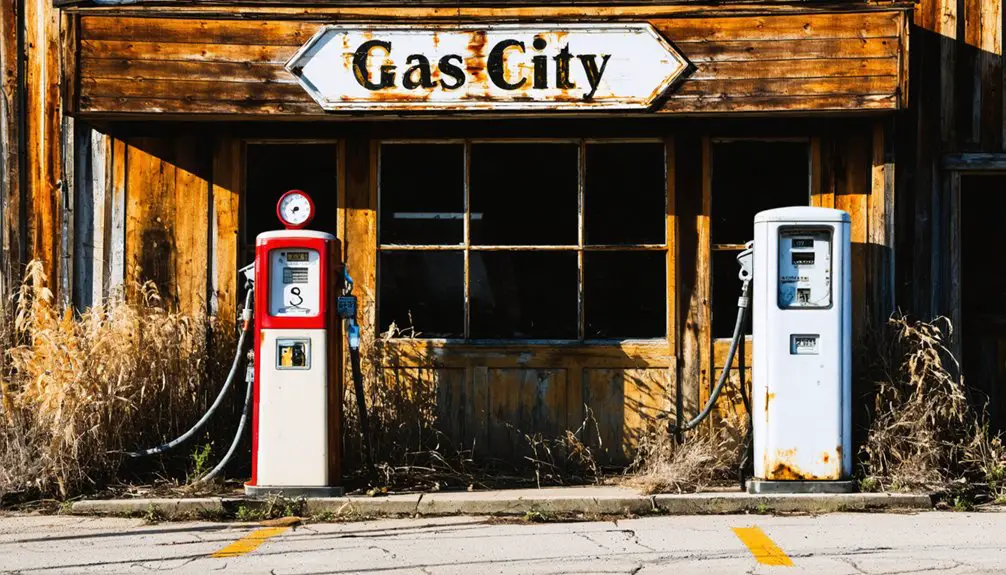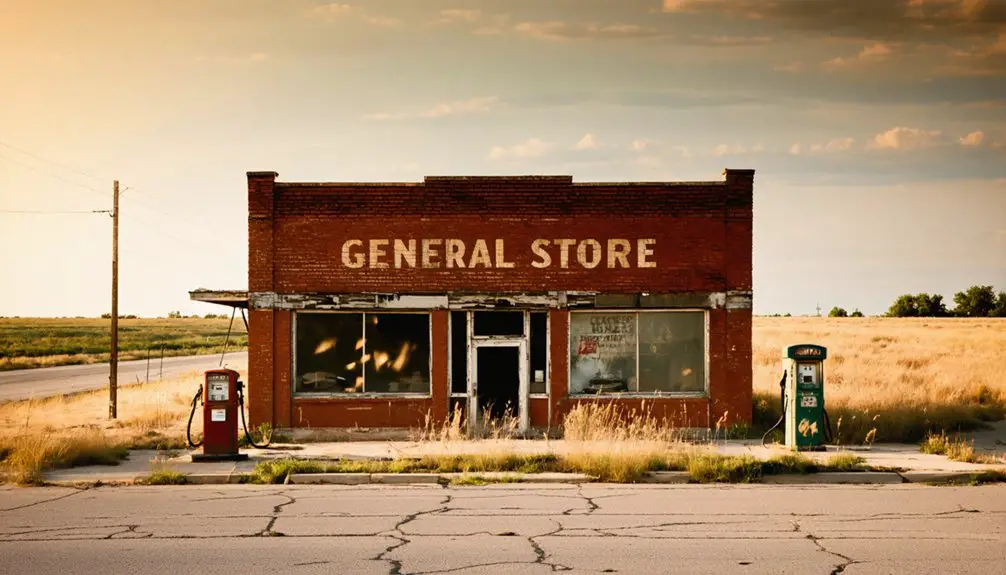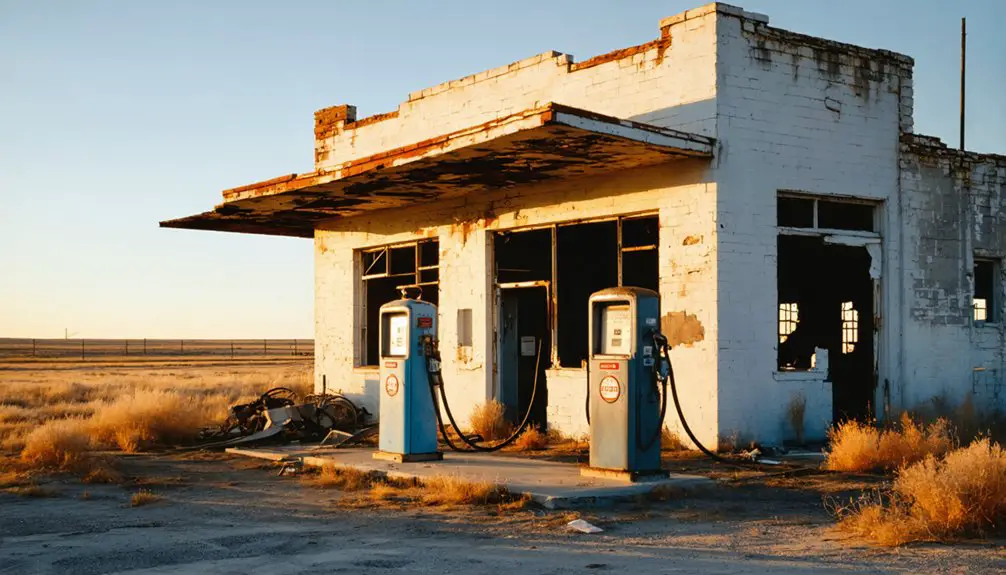You’ll find Gas City‘s remnants in northeastern Oklahoma, where a thriving natural gas boomtown of 800 residents once stood in the early 1900s. The town emerged after significant gas deposits were discovered in 1901, leading to rapid development with processing facilities, blacksmith shops, and essential rail connections. By the late 1970s, depleted resources and bypass highways led to its abandonment. The scattered foundations and weathered artifacts tell a compelling story of America’s resource frontier.
Key Takeaways
- Gas City emerged in late 19th century Oklahoma near natural gas deposits, flourishing during the early 1900s with hundreds of residents.
- The town’s economy centered on natural gas extraction, with the Hugoton-Guymon Gas Field discovery in 1920 fueling peak growth.
- Depletion of natural gas reserves and failure to diversify the economy led to Gas City’s eventual abandonment.
- The construction of major highways bypassing Gas City and end of rail service increased isolation, accelerating population decline.
- Today, only scattered remnants and foundations remain, with native vegetation reclaiming the former streets and infrastructure.
The Rise of a Resource Frontier Town
As Oklahoma emerged from its frontier status in the late 19th century, Gas City sprang to life near substantial natural gas deposits that would shape its destiny.
Gas City arose from Oklahoma’s frontier lands, its future intertwined with the rich natural gas deposits beneath its soil.
Like many other boom-and-bust cycles that created ghost towns across the state, Gas City’s story reflected the volatile nature of resource-dependent communities.
You’d have witnessed a remarkable resource migration as prospectors, workers, and merchants flocked to this promising location, drawn by the discovery of valuable energy reserves.
The community dynamics quickly evolved as the population swelled to several hundred residents. Like many other Oklahoma boomtowns, Gas City’s development was fueled by the discovery of natural resources in the region.
You’d have seen a bustling frontier town materialize, complete with gas processing facilities, blacksmith shops, and general stores.
The town’s strategic position near railroad expansions and emerging economic hubs made it an ideal settlement choice.
Schools and post offices soon followed, while planned rail lines promised to connect Gas City’s resources to broader markets, cementing its role in Oklahoma’s rapid transformation from frontier to industrial hub.
Peak Years and Economic Activity
During the early 1900s, you’d have witnessed Gas City’s meteoric rise after the discovery of significant natural gas deposits beneath Oklahoma’s resource-rich frontier lands.
Like many abandoned mining towns across Oklahoma, Gas City’s early prosperity attracted hundreds of ambitious workers and their families seeking opportunity in the booming energy industry.
You’d have seen entrepreneurs and workers flooding into the area, establishing drilling operations and support businesses that transformed the once-quiet landscape into a bustling hub of industry.
The town’s strategic position along key rail lines amplified its economic potential, as you’d have observed freight cars regularly transporting equipment, supplies, and workers to support the expanding natural gas operations.
Similar to the fate of Glen Rio Texas, Gas City’s eventual decline would mirror that of other ghost towns that once thrived during America’s industrial expansion.
Natural Gas Discovery Period
The discovery of natural gas in Oklahoma transformed the state’s economic landscape when commercial usage began in 1901 at a Tulsa brick plant utilizing Red Fork sand wells.
You’ll find that early natural gas exploration started in northeastern Oklahoma, where Muskogee’s wells were drilled as early as 1894, though they lacked a local market at the time.
The discovery impact rippled across the state as major fields emerged in rapid succession. Oklahoma Natural Gas Company began tapping into these valuable north-central oil fields after its founding in 1905.
The Bartlesville-Dewey Field kicked off production in 1904, followed by Glenn Pool in 1905, Hogshooter in 1906, and Boynton in 1910. The discovery of the Hugoton-Guymon Gas Field in 1920 would become a milestone, developing into the largest natural gas field in Oklahoma.
Economic Growth and Development
While Oklahoma’s early gas discoveries laid the foundation, peak economic activity wouldn’t emerge until the late 1970s, when industry employment skyrocketed from 40,000 workers in 1975 to nearly 120,000 by 1982.
You’d find one in every twelve Oklahoma workers employed in the oil patch during this golden era, earning wages well above the state average.
This prosperity drove ambitious urban planning initiatives across Oklahoma’s cities.
You’ll see evidence in Oklahoma City’s impressive skyline, which grew even during the Great Depression as oil companies erected their headquarters.
The industrial growth extended beyond the major metros – towns like Cushing, Ponca City, and Bartlesville flourished as energy sector revenues funded large-scale development projects and critical infrastructure.
The discovery of the Glenn Pool field in 1905 marked one of the state’s earliest major oil fields, setting a precedent for future development.
From 1900 to 1930, the state experienced a dramatic shift as agricultural employment dropped from 70% to 37% of the workforce.
The sector’s strength propelled Oklahoma’s GDP growth to 4.3% annually during the 2011-2015 boom years.
Factors Behind the Decline
Gas City’s decline stemmed primarily from the depletion of its natural gas reserves, which had provided the town’s economic foundation and employment base.
You’ll find that the town’s isolation increased when rail service ended and new highway systems bypassed the community, severely impacting businesses that relied on transport-related commerce.
The town’s inability to diversify its economy beyond resource extraction left it particularly vulnerable when the gas industry contracted, leading many residents to seek opportunities elsewhere. Similar to Beer City’s fate when Oklahoma Territory jurisdiction brought strict law enforcement, Gas City’s economic activities became unsustainable. Like Skedee, the town experienced a dramatic population drop when rail lines flooded, further accelerating its abandonment.
Resource Depletion Impact
Once prosperous due to abundant natural resources, Gas City’s dramatic decline stemmed primarily from the systematic depletion of its essential mineral deposits and subsequent economic fallout.
You’ll find that poor resource management led to rapid over-extraction, leaving the town’s economic foundation severely compromised. The sustainability challenges became apparent as reserves dwindled, forcing businesses to close and workers to seek opportunities elsewhere.
Without a diversified economy to fall back on, Gas City couldn’t withstand the impact of resource exhaustion.
The town’s mono-industrial focus meant that when extraction became financially unfeasible, the population plummeted by more than 80%.
The remaining infrastructure fell into disuse as commercial activity ceased, transforming a once-bustling community into a stark reminder of boom-and-bust cycles in resource-dependent towns.
Transportation Route Changes
Beyond the exhaustion of natural resources, shifting transportation routes dealt another devastating blow to Gas City’s survival.
You’ll find that route abandonment played a significant role, as railroad companies reconfigured their lines away from the town, severing essential connections to economic hubs. When the rail traffic declined, local businesses that depended on freight and passenger services couldn’t sustain themselves.
The bypass effects hit even harder when major highways were constructed, deliberately routing traffic away from Gas City.
You’d have seen this same pattern across Oklahoma, where towns withered once they lost their transportation advantages. As America shifted from rail to automobiles and trucking in the mid-20th century, Gas City’s isolation from new transportation corridors sealed its fate.
Without access to these critical arteries of commerce, the town’s remaining residents had little choice but to leave.
Economic Diversification Failure
Despite early prosperity from natural gas extraction, the town’s vital failure to diversify its economic base ultimately contributed to its downfall.
You’ll find that Gas City’s leaders missed vital opportunities to develop economic resilience strategies during the boom years, leaving the community vulnerable when natural gas resources began to deplete.
While neighboring towns invested in manufacturing, agriculture, or service industries, Gas City remained singularly focused on gas extraction.
The absence of community planning initiatives prevented the development of alternative business sectors that could have sustained the local economy.
When market changes and resource exhaustion hit, you could see how this lack of diversification triggered a devastating chain reaction – businesses closed, skilled workers left, and municipal services declined, transforming a once-thriving town into a shell of its former self.
Remnants and Current Conditions

The scattered remnants of Gas City, Oklahoma tell a story of abandonment and natural reclamation. You’ll find crumbling foundations peeking through tall grass, while rusted metal and broken glass litter the ground where businesses once thrived.
Abandoned foundations and debris tell silent stories of Gas City’s past, as nature slowly erases traces of human habitation.
Native vegetation has steadily reclaimed the flat plains, transforming paved streets into little more than dirt paths.
If you venture onto this private property, you’ll discover weathered artifacts of daily life scattered among deteriorating infrastructure. The site’s physical remnants have surrendered to decades of environmental reclamation, with wildlife now inhabiting areas where people once lived and worked.
No intact buildings remain standing – just fragments of sidewalks, fence posts, and building foundations that hint at Gas City’s former existence as a bustling community.
Life in the Heyday
During the early 1900s oil boom, Gas City emerged as a vibrant hub of industrial activity, drawing thousands of workers and entrepreneurs to Oklahoma’s promising oil fields.
You’d find yourself in a bustling frontier community where fortunes could change overnight, with streets full of oil workers, merchants, and fortune-seekers.
Life in Gas City revolved around these key aspects:
- Hard labor in the oil fields dominated daily routines, with workers facing dangerous conditions and long hours.
- Community dynamics centered on shared spaces like churches, saloons, and dance halls, where cultural activities helped forge bonds despite the transient population.
- Free-wheeling entertainment included rowdy saloon nights and community gatherings, reflecting the untamed spirit of frontier boomtown life.
The town’s layout supported this industrial lifestyle, with wide streets accommodating heavy equipment and commercial districts serving the working-class population.
Legacy and Historical Significance

Standing as a symbol to Oklahoma’s volatile resource-driven past, Gas City’s legacy embodies the dramatic boom-and-bust cycle that shaped America’s early oil frontier.
You’ll find its story woven into the cultural memory of the region, where the transient demographics of oil workers defined the community’s character and development.
Today, Gas City serves as a stark reminder of how resource-dependent economies can collapse. Its decline, marked by an 80% population loss, offers critical lessons about economic diversification.
You can trace the town’s influence through early energy infrastructure developments and labor patterns that transformed Oklahoma’s landscape.
While physical remnants may be scarce, Gas City’s cautionary tale continues to resonate, particularly as modern communities face similar challenges of resource dependency and economic sustainability.
Frequently Asked Questions
Are There Any Documented Paranormal Activities or Ghost Sightings in Gas City?
You won’t find any confirmed ghostly encounters or spectral sightings in official records. Unlike other Oklahoma ghost towns with rich paranormal histories, there’s no documented evidence of supernatural activity here.
What Happened to the Original Town Records and Documents?
You won’t find original town archives today – they’ve likely been lost to time through neglect, natural disasters, or poor historical preservation efforts after the town’s economic collapse and rapid abandonment.
Did Any Famous Historical Figures Ever Visit Gas City?
You won’t find any documented famous visitors or significant historical events involving notable figures in this town – historical records don’t show evidence of any celebrated personalities passing through.
Were There Any Notable Crimes or Scandals in Gas City?
While you won’t find records of mysterious disappearances or unsolved cases specific to Gas City itself, the surrounding No Man’s Land region was notorious for outlaw activity and lawlessness before Oklahoma’s statehood.
What Indigenous Tribes Originally Inhabited the Area Before Gas City?
You’ll find the Osage Nation’s cultural legacy dominates this area, though Comanche, Kiowa, and other Plains tribes’ history shows they traversed these lands for hunting and raiding before formal reservations existed.
References
- https://en.wikipedia.org/wiki/List_of_ghost_towns_in_Oklahoma
- https://www.okhistory.org/publications/enc/entry?entry=GH002
- https://www.youtube.com/watch?v=5d-wHDTIbb0
- https://www.youtube.com/watch?v=kS5yEKzlFoE
- https://the405voyager.com/5-ghost-towns-in-oklahoma-that-will-give-you-the-creeps/
- https://www.potawatomi.org/blog/2021/04/09/remembering-potawatomi-ghost-towns/
- http://www.ou.edu/news/articles/2024/may/ou-researcher-unveils-book-of-oklahomas-ghost-towns.html
- https://www.okhistory.org/publications/enc/entry?entry=OK068
- https://www.ou.edu/content/dam/ogs/documents/information/Boyd 2002 Notes Oklahoma Natural Gas Past Present and Future.pdf
- https://www.oklahomaminerals.com/look-back-one-biggest-oil-gas-fields



